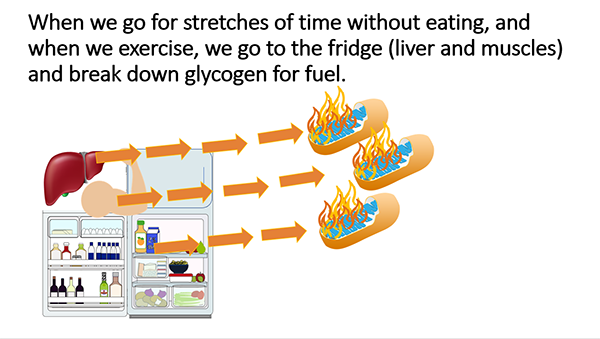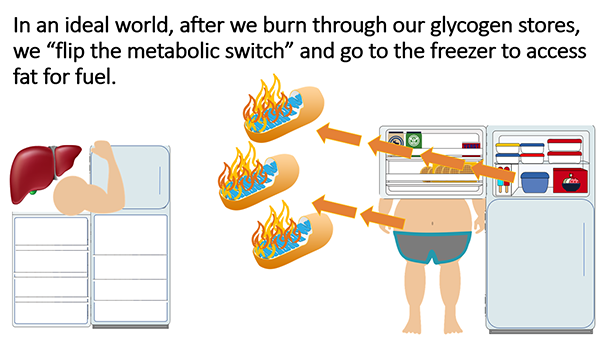I often think of the expression “Bend so you don’t break” when I need to remind myself to be flexible in my mindset. As a yoga enthusiast, it also makes good literal sense to be physically flexible. But what about metabolic flexibility? I think the saying applies here too. Being metabolically flexible can reduce the risk of common health conditions such as type 2 diabetes, metabolic syndrome and many types of cancer.
What exactly is metabolic flexibility and why should you want it?
Metabolic flexibility describes the body’s ability to easily switch back and forth between using glucose and using fat for energy. Throughout human history when food was not as readily available, metabolic flexibility allowed people to fuel off of fat stores and continue to have energy and mental clarity while going for some longer stretches of time without eating and while hunting for food. In modern times, being metabolically flexible can help you:
- Avoid crashes and getting hangry between meals.
- Stay mentally sharp between meals.
- Lose body fat, if needed/desired.
- Improve your workout performance.
- Reduce your risk of some chronic diseases.
To understand the concept, it helps to know what happens to our food when we eat and what happens with energy stores when we haven’t eaten in a while. Thank you to Dr. Jason Fung for the following analogy:
*Exercise also helps us to tap into our fat stores for fuel.
* This is a bit of an oversimplification in that the process is more like a metabolic dimmer switch —as glycogen slowly gets depleted, fat burning slowly ramps up.
The challenge is that most people have a steady supply of food throughout the day, and our liver glycogen (carbohydrate) stores don’t get fully depleted overnight, so many of us rarely need to tap into our fat stores for fuel. The body recognizes that it hasn’t relied heavily on the mechanisms to tap into body fat, so it doesn’t devote many resources (e.g., enzymes) to support pathways that enable fat burning. Without enough of the enzymes needed for fat breakdown and utilization in the right places, when you run low on glucose or glycogen (when you don’t eat at your regularly scheduled times), you may feel like you are starving and get cranky because the fat is harder to access and break down (like food in the freezer that takes more work to thaw before cooking).
What is metabolic flexibility and why should I care? #saslife Click To TweetHow can you improve metabolic flexibility?
To start the journey to metabolic flexibility, consider some of the following strategies:
- Eat full meals, limit snacks between meals and avoid overeating.
- Work up to fasting for 12 hours between dinner and breakfast and eventually longer intermittent fasts.
- Eat balanced meals made with real foods, avoid excess carbohydrates and limit ultra-processed foods. A ketogenic eating pattern (very high fat, very low carb, moderate protein) can also speed up the process of becoming metabolically flexible but is not required and requires proper education before starting.
- Increase exercise, and try exercising before eating.
- Get good sleep and manage stress to keep hormones balanced.
- If you are adventurous, you might even consider cold plunges.
Over time your genes will upregulate production of the key enzymes so it becomes easier to flip the metabolic switch to use fat for fuel — TA-DA!…metabolic flexibility — more energy, more mental clarity and less irritability when you run low on glucose for fuel.
It’s important to note that there is a transition period where a metabolically inflexible body is not yet efficient at getting energy from fat stores, so mitochondria aren’t yet getting enough fuel, and this may be felt as low energy, general malaise, headaches, brain fog, etc. People who have insulin resistance may struggle a bit more to develop metabolic flexibility because high insulin levels (associated with insulin resistance) promote energy storage as opposed to energy mobilization, making it more challenging to access fat stores. For someone with significant insulin resistance, working up to longer and more intense interventions over time with the help of a health care provider can lead to increased metabolically flexibility and eventual freedom from many struggles associated with food.
Simple Sautéed Cabbage
Makes 6 servings
PRINT RECIPE
This dish pairs well with pork chops, or make it a one pan meal by adding sausage directly to the pan before cooking the cabbage.
Ingredients
1 Tbsp avocado oil
1 small head of red or green cabbage, thinly sliced
2 large carrots, shredded or chopped in a food processor
¼ cup apple cider vinegar or for a sweeter option, balsamic vinegar
Salt, to taste
½ tsp black pepper
¼ cup chopped parsley (optional)
Instructions
- Pre-heat a large skillet over medium high heat.
- Add about 1 Tbsp avocado oil and cabbage to skillet.
- Add shredded carrot, salt, pepper and vinegar.
- Sauté for about 5 minutes, stirring occasionally for even cooking.
- Remove from heat, mix in parsley and serve.
Note: For an Asian flavor twist on this dish, substitute sesame oil in place of avocado oil, omit black pepper, add red bell pepper, ginger and garlic while sautéing, and serve topped with sesame seeds and green onion instead of parsley.






